Today's Notables
feast in Xiamen
October 2012
Hisashi Furuichi
President and C.E.O.
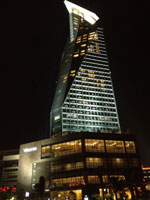
Every year, I take my traditional food tour on the Marine Day three-day weekend. This year, our destination was Xiamen. Not only is the name Xiamen unfamiliar, most people would not be able to point it out on a map at all. Even most Chinese people would not know anything about Amoy, which is Xiamen City. Originally, the name Xiamen was written "下門" (pinyin: Xiàmén; Pe̍h-ōe-jī: Ē-mn̂g; literally "lower gate", BP: Êbbńg), possibly referring to its position at the mouth of the Nine Dragon River. The Zhangzhou dialect of Min Nan reads these characters as "ε̄-mûi ", the source of the name "Amoy". The dialect is still spoken in the west and southwest of the city. Later, the authorities found "下門" too unrefined and changed the name to the modern toponym "厦門", which has the same pronunciation in Mandarin—not in Min Nan, however—and literally means "The Gate of the Grand Mansion". The name continues to be pronounced “Ē-mn̂g” in Min Nan, effectively using the older name. (Source: Wikipedia)
Based on this somewhat confusing history behind the name, it was not surprising that when I told a Chinese acquaintance I was going to Amoy in China and he said he had never heard of such a place nor had he ever heard the name. I replied that it is because China is such a big country but if I had written out the characters, I am sure he would have understood.
Amoy is an island located on the coastline opposite of Taiwan, and it is a provincial city of Fujian province, which was designated as special economic area in 1980 and is well known as the birthplace of successful Chinese expatriates living around the world. Fujian Province is known from marble, granite and other such materials as well as teas such as oolong tea, pu’er tea and others. Probably for that reason, the port of Amoy is bustling with trade, and is in the top five ports in all of China in terms of volume and scale. Of the cities in China that I have visited, Amoy is above the rest as far as cleanliness and you see very few motorcycles or bicycles because they seem to be prohibited. We stayed at the Westin Amoy that just opened in May. It is one of the tallest buildings in Amoy with 45 floors. The design is very avant-garde and looks like a robot that might appear in the movie Transformers. Despite the hotel being very new, there were cracks in the marble walls of the bathroom and no plug in the bathroom for the hair dryers, which is typical in many places in China. Nevertheless our stay was comfortable, but the primary purpose of this group is not the hotel stay or sight-seeing but food so I would be remiss in not sharing our gourmet adventures.
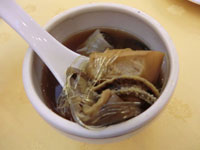
The main purpose for the visit was to eat Buddha Jumps over the Wall or pronounced bucchoutan in Japanese. Bucchoutan is soup that is a delicacy. It contains plenty of dried delicacies simmered over a period of several hours and is made using methods developed in Fujian. It is fabled that the aroma of the soup was so enticing that the monk trainees scaled the walls of the temple to get the soup and thus the name was set. I have eaten bucchoutan several times in Japan, but never at the birthplace of the soup and thus, one of the reasons I wanted to visit Fujian Province. Amoy, the place to eat the soup, is still 300km from Fuzhou, which is the capital of Fujian Province. If Buddhist monks are willing to jump over a wall to eat the soup, I guess we could endure a 4-hour, one-way trip so we made a special trip to Fuzhou specifically to taste Buddha Jumps over the Wall.
The main ingredients are dried abalone, dried scallops, shark's fin, fish air bladder, dried shrimp, Jinhua ham, dried sea cucumber, dried mushrooms, pig tendon, ginseng, dried longan, shaoxingjiu, etc. Everything is put into a pot and after tightly sealing, it is simmered for 8 hours. Because most of the ingredients are dried, there is very little greasiness, making the soup rather light. Amino and succinic acid are readily present, adding to the delicious flavor. If you look up Buddha Jumps over the Wall on the web, you will find a famous Chinese restaurant in Yokohama that serves the soup. However you have to reserve it 5 days ahead and it costs 40,000 Japanese yen for two people. In comparison, the Buddha Jumps over the Wall soup we had in Fuzhou was a little over 1,000 yen per person. (^o^)
Other than the soup, this region is also famous for Hakka cuisine eaten by Hakka people. Over history, the Hakka people which are Han Chinese, escaped war by moving to the mountains, continually making that their permanent residence. From the point of view of the natives that have lived there all along, they are viewed as outsiders and thus became known as Hakka. They currently live in Guangdong, Fujian, Jiangxi, and other mountain regions. Over history the Hakka cuisine eaten by this group of people includes food preserved by spices as well as poultry and other farm animals they raised. They also eat animals and plants that grow in the wild in the mountains such as bamboo, vegetables, mushrooms, river fish, frogs, etc. Other staples include rice cultivated in the southern China, processed foods and sweet potatoes that are prepared simply by steaming or cooking. Because of the large incidents of migration, they often ate food that was easily mobile such as salted, dried or smoked food, which allowed them to recover sodium lost through perspiration while working and helped them maintain their strength. The food is rather fatty, salty and rich in flavor.
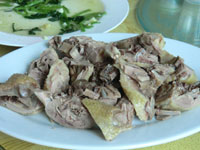 |
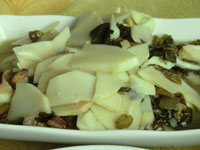 |
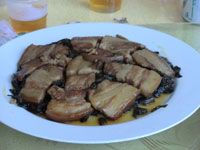 |
Along with eating Hakka cuisine, our group visited the world heritage, Fujian Tulou or it’s called Hakka Tulou. On the way, we saw houses made out of earth before coming to the small town in the country where we had Hakka cuisine. We also had a dish somewhat like Dongpo pork (Tonporo) with sautéed pickled greens under it, a dish with duck, an herb (it was more like a tree root) soup, and a bamboo dish--they were all very delicious. To my surprise, however, the food was not as greasy or salty has I had expected. From the window of the restaurant, you could see behind the restaurant where ducks and chickens roamed around so I am sure the food we were eating was very fresh.
The Fujian Tulou was built between the 12th and 20th centuries and is a large concentration of residences that are either round or rectangular. From the outside, it looks like a wall surrounding the area almost like a fortress with only one entrance. The diameter of the building is about 30m to 50m and is about 3 to 5 floors high. Approximately 80-100 families lived together in the buildings. The wall is at least 180 centimeters thick and was made by mixing glutinous rice and brown sugar cane mixed with sand and was then packed around a structure of trees, which made it very strong. Even after 700 or 800 years, the buildings are kept in a condition that would allow people to live in them. Because we spent a lot of time moving around, we did not get to visit very many other places but it is definitely worth the effort to visit these important places of historical interest. We decided that Beijing would be the destination for our next visit as we concluded this one.
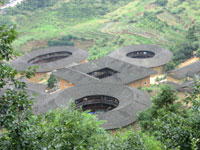 |
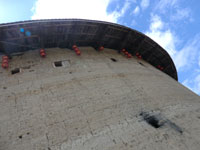 |
HOME > What’s New > Today's Notables > Details














